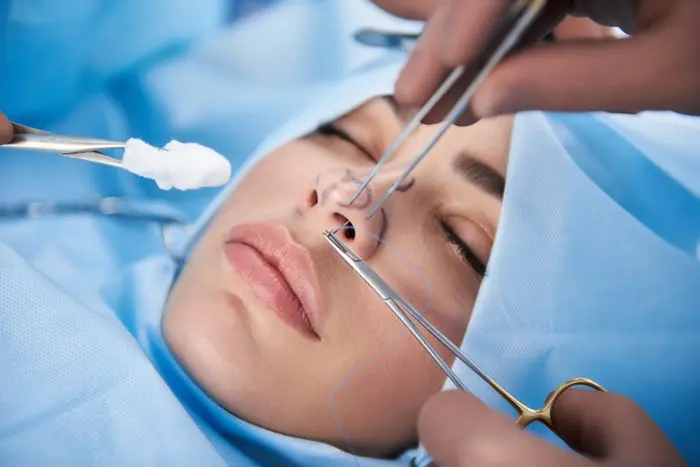When it comes to rhinoplasty, one size does not fit all. Dr. Joanna Kam, a leading expert in facial plastic surgery, tailors her approach to each patient’s unique anatomy, with a particular focus on how nasal skin thickness influences the surgical process and outcome. At Kam Facial Plastic Surgery, Dr. Kam ensures that every rhinoplasty procedure is personalized to address individual characteristics like skin type, facial features, gender, ethnicity, and nasal structure.
Understanding how the thickness of a patient’s skin impacts the rhinoplasty procedure is crucial for achieving the best results. Thick nasal skin, in particular, presents distinct challenges and requires specialized techniques to ensure that the final appearance is both harmonious and well-defined.
Nasal skin thickness plays a pivotal role in shaping the final results of rhinoplasty. Thicker skin can reduce the visibility of finer details in the nose and may prevent subtle changes from becoming noticeable. This can lead to a less refined appearance, especially in patients who seek more dramatic changes. Conversely, thin skin tends to reveal every nuance of the underlying nasal structure, making precision even more important.
Dr. Kam explains that by thoroughly evaluating a patient’s nasal skin thickness, a skilled surgeon can tailor the surgical approach to ensure the best aesthetic outcome. “The goal is not just to modify the nose but to achieve a balanced, natural look that complements the patient’s entire facial framework,” she says. By understanding both the structural and aesthetic implications of skin thickness, Dr. Kam is able to plan each surgery with greater accuracy and foresight.
For patients with thick skin, the approach to rhinoplasty must be adjusted. Dr. Kam uses cartilage grafts to support and strengthen the nasal framework. These grafts are particularly important when dealing with the thicker subcutaneous fatty layer that can obscure the finer details of the surgery. In contrast, for patients with thin skin, the surgeon focuses on minimizing scarring while enhancing definition, using more delicate techniques to preserve natural contours and avoid visible imperfections.
The approach for thick-skinned patients also involves more attention to the subcutaneous tissue, which can retain fluid and cause prolonged swelling. This requires specialized techniques to reduce swelling and scarring during recovery. “With thick skin, the recovery process may take longer, and the fine details of the reshaped nose may take a bit more time to become visible,” Dr. Kam notes. “In some cases, a revision rhinoplasty may be needed to achieve the final desired appearance.”
One of the most common challenges with thick skin rhinoplasty is prolonged swelling. Thick skin tends to retain more fluid after surgery, which can extend the healing period and make it difficult to see the final results immediately. As a result, patients may experience a delay in seeing the desired outcome, which can lead to concerns about the surgery’s success.
To mitigate these issues, Dr. Kam uses advanced intraoperative techniques, such as the application of specific materials and methods designed to reduce scarring. Additionally, postoperative injections may be used to decrease fluid retention and ensure a smoother recovery. These interventions help sculpt the nasal structure more precisely, ultimately enhancing definition even in patients with thicker skin.
Dr. Kam’s expertise extends beyond just basic rhinoplasty. Her practice includes open, closed, ethnic, feminization, and functional rhinoplasty, with particular attention to the nuances of thick skin rhinoplasty. She is one of the few surgeons who have mastered the specific techniques required for these challenging cases.
The rhinoplasty process at Kam Facial Plastic Surgery typically begins with a thorough consultation, where Dr. Kam discusses the patient’s goals, skin type, and overall health. The surgery, usually performed under IV sedation or general anesthesia, takes about 2 to 3 hours, depending on the complexity. Recovery is typically swift, with most patients able to resume normal activities within a week. Final results can be seen within 12-18 months as swelling continues to subside.
In addition to rhinoplasty, Kam Facial Plastic Surgery offers a range of non-surgical facial rejuvenation treatments. These include Botox, dermal fillers, and laser skin resurfacing, which can complement surgical results or be used as standalone procedures to enhance facial appearance.
Dr. Kam is also skilled in performing facelifts, brow lifts, eyelid surgeries, and neck lifts, as well as facial reconstruction after skin cancer removal. Her patients benefit from her holistic approach to facial aesthetics, which combines surgical expertise with a deep understanding of each individual’s unique facial anatomy.
Dr. Joanna Kam is board-certified by the American Board of Otolaryngology-Head and Neck Surgery and has received specialized training in facial plastic surgery. Her practice, Kam Facial Plastic Surgery, is based in Voorhees and Sewell, NJ, where she offers a wide range of cosmetic and reconstructive procedures. Dr. Kam attended Virginia Tech Carilion School of Medicine on a full-tuition scholarship and completed her residency at the Henry Ford Health System in Detroit, MI.
You Might Be Interested In:

